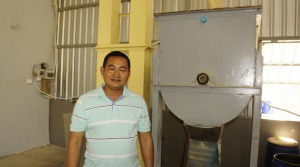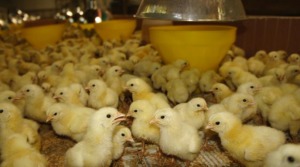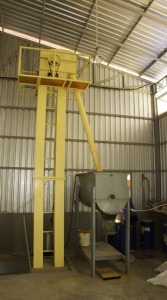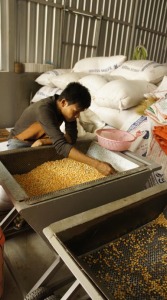Supplying superior quality chicken to more affluent consumers in Cambodia’s capital city is the key to an ambitious Cambodian poultry farmer’s expansion plans.

Dr Bun Sidoeun operates a 60-hectare farm with wooden houses (9x56x2.7m) that hold a total of 4,000 birds per week. The housing is elevated 1.7 meters, and manure drops to a dropping zone about 30 cm above the ground so that the manure will be not be drained by flash floods. The house has a five-year useful life and can complete six production cycles/year.
Dr Bun Sidoeun, owner of Mitsam Lanh, said his company which currently produces around 4,000 birds/week is targeting weekly output of 16,000 birds/week by 2015.
Apart from its main markets in Sihanouville, Kampong Cham, Kampote and nearby cities, Mitsam Lanh plans to penetrate the Phnom Penh market by targeting customers who prefer good quality, hygienic meat.
Per capacity consumption of poultry in the capital city is more than 12 kg/person/year, about three times higher than the national average of 4 kg.
With a doctorate in poultry nutrition, planning for large-scale feed production is not a challenging task for Dr Sidoeun, whose goal is to formulate healthy, high performance feed at a competitive price.
“I am developing a niche segment for customers who prefer lean and somewhat tough meat,” he said.
At present, Dr Sidoeun produces the birds on his own farm, but he will start to develop a fair and transparent contract growing system in 2015.

Chicks are brooded in a separate house for one week before moving to the growing-finishing house. Rearing density is 40 chicks/sq m, brooding temperature 32-33C.
Farmers will invest in a poultry house and use inputs including chicks, feed, vaccines and other supplies supplied by Mitsam Lanh. Feed costs will be 5% lower than other commercial feed suppliers in the market.
The company will buy back the birds at pre-agreed prices. If the market price is lower than the agreed price, he will buy 50% of the birds at the agreed price and the rest will be sold at the market price.
Contract growing is a win-win for both parties, he said. Mitsam Lanh saves the US$12,000 cost of building new poultry houses while growers save around US$12,000 in working capital which includes the cost of the chicks, feed, medications and vaccines.
The expenses are settled after the birds are harvested.
Key to achieving this vision is the development of marketing channels with retailers willing to sign a six-month pricing contract to minimize the impact of market volatility.
Currently, Cambodian traders who process and market locally raised live birds enjoy a margin of at least US$1.20/kg. This excessively large margin has been maintained for a long time, said Dr Sidoeun.
In order to control quality, he plans to start his own small processing plant with a 1,000 birds/day capacity. Meanwhile, appraisal of financial and operational viability is underway. The processing operation will provide a basis for starting a future retail business while assuring a steady margin for his production.
By 2015, the company hopes to be producing 16,000 broilers/week and coloured birds at a rate of 8,000/week.
The day-old chicks (DOC) will be bought from reliable suppliers via an agent who sources the chicks from Thailand and Vietnam. Chicks from Vietnam have an edge due to the shorter traveling distance which makes them cheaper by at least US$0.20 apiece.
The main concern is keeping costs low because the Cambodian industry is forced to compete with broilers from Thailand and Vietnam. With no tariffs in place, controlling costs is the only way to achieve long-term success, he said.
He is confident that backward integration will result in superior meat quality which will in turn win customer loyalty.
Feed
Mitsam Lanh farm produces corn-soy rations for internal use and for sale locally. Its 300-kg/batch single-shaft mixer with a one-tonne double shaft paddle mixer will be replaced in 2015. Starter feed offers CP22%, energy 3,000 kcal/kg; grower CP20%, energy 3,050 kcal; and finisher 19%, energy 3,100 kcal.

Mitsam Lanh’s US$20,000 feed mill, consisting of a hammer mill, bucket elevator and a mixer producing mash feed at 40 tonnes/month capacity
Dr Sidoeun said the mill is currently producing around 40 tonnes/month.
The main ingredient is corn, making up 60% of the total. The rest is soybean meal with palm oil, fish meal, synthetic amino acids and phytase.
Since the birds are reared in open housing, there needs to be a slight adjustment during the summer to a higher ratio of amino acids and energy to offset reduced feed intake.
Antibiotics such as amprolium are applied periodically to prevent necrotic enteritis and coccidiosis. A 21-day withdrawal period is observed.
The breed used is Ross 308, with a rearing period of 40 days, FCR 1.7 and bodyweight 2.3 kg. The birds at seven days weigh 180 grams.
Bodyweight targeting is a key metric for tracking overall performance. As a rule of thumb, if average bodyweights during the first week slip 5-6 grams below standard, then the birds will likely end up at least 60 grams lighter than the target weight of 2.3 kg at 40 days of age, he said.
Production cost is US$1.65/kg versus a market price of US$1.70/kg. Given current performance and market prices, the net profit per harvest of 4,000 birds could be around US$2,000.
In a bid to reduce feed costs, Mitsam Lanh is encouraging farmers nearby to grow corn to supply its operation.

